Kratom tolerance can be a challenge for many users. Understanding its causes and signs is the first step to effective management.
We at Kratom Cafe have compiled practical tips on how to handle tolerance. Whether through rotating strains or making lifestyle changes, there are several strategies to explore.
Understanding Kratom Tolerance
Kratom tolerance occurs when the body becomes accustomed to a certain dose, leading to diminished effects. It’s vital to understand why tolerance builds to manage it effectively.

Kratom tolerance is the phenomenon where the body requires higher doses over time to achieve the same effects. This typically happens because the receptors in the brain that kratom interacts with become less sensitive.
Several factors can cause tolerance. Chiefly, frequent and high-dose usage accelerates the body’s adaptation. Rotating strains too infrequently can also contribute to a faster tolerance build-up.

Signs of tolerance include needing higher doses to feel the same effects, shortened duration of effects, and decreased intensity. Recognizing these signs early can help in managing kratom use effectively.
Some practical strategies for managing tolerance are:
-
Rotate strains frequently: Strain rotation every few days can help mitigate tolerance.
-
Take breaks: Periodic breaks, known as “kratom vacations”, are critical. Taking 1-2 days off each week can reset tolerance levels.
-
Adjust dosages: Using the lowest effective dose minimizes the risk of tolerance.
-
Monitor intake: Keeping a usage diary can help track patterns and adjust habits accordingly.
For additional insights on kratom effects and strains, check out these resources on different types of kratom veins and strain comparison.
Recognizing and understanding these aspects of kratom tolerance can help maintain its benefits over the long term.
Practical Tips to Manage Kratom Tolerance
Managing kratom tolerance is essential for maintaining its effectiveness. Here are several specific strategies to keep tolerance in check:
Rotating Strains and Keeping It Fresh
Rotating strains can help avoid building a tolerance to any single strain. Different kratom strains have varied alkaloid profiles, which interact differently with the body. By switching between strains like Green Maeng Da, White Borneo, and Red Thai, users can effectively prevent the body from becoming overly accustomed to one strain’s effects.
For instance, some users rotate weekly or bi-weekly:
-
Start with Green Maeng Da for the first week.
-
Switch to White Borneo in the second week.
-
Use Red Thai in the third week.
-
Return to Green Maeng Da in the fourth week.
Such rotation helps in keeping the effects potent and consistent.

Managing Dosage Wisely
Effective dosage management is another key strategy. Using the lowest effective dose minimizes the risk of building tolerance. It’s important to gradually adjust the dose rather than making significant jumps.
Practical tips for dosage management include:
-
Start low: Begin with the smallest dose that provides relief or desired effects.
-
Increase gradually: Only increase if necessary and do so incrementally.
-
Track your dosage: Maintain a dosage journal to observe trends and make informed adjustments.
For instance, a user might start with 2 grams of Green Maeng Da and find it effective. Only if they feel the effects waning over time would they increase by 0.5 grams.
Taking Regular Breaks
Periodic breaks, or “kratom vacations”, offer another effective method to reset the body’s sensitivity to kratom. Regularly taking short breaks prevents tolerance from building up excessively.
A recommended break schedule could look like this:
-
Use kratom for five days.
-
Take two days off each week.
-
Consider longer breaks (one week off every two months) for a complete reset.
A study conducted by the Johns Hopkins University found that taking breaks could significantly reduce the likelihood of developing a substance use disorder.
Combining these techniques can be incredibly effective. For additional tips on kratom consumption, check out safe kratom consumption.
Here’s a quick recap of essential strategies:
-
Rotate kratom strains regularly.
-
Use the lowest effective dose.
-
Track and adjust dosages gradually.
-
Take regular breaks to reset tolerance.

By implementing these strategies, users can maintain the effectiveness of kratom and reduce the risk of developing a high tolerance.
What Supplements and Lifestyle Changes Can Help?
Incorporating certain supplements and lifestyle changes can effectively manage kratom tolerance alongside regular strategies like rotating strains and taking breaks.
Magnesium to Combat Tolerance
Magnesium is known for its ability to modulate NMDA receptors in the brain. These receptors play a significant role in the development of tolerance to various substances, including kratom. Studies suggest that magnesium supplements can help in reducing tolerance by dampening the activity of these receptors.
-
Magnesium glycinate or magnesium citrate are popular choices because they are easily absorbed by the body.
-
Aim for a daily intake of around 400mg of magnesium, which aligns with the recommended dietary allowance.
Given this role, magnesium can be an invaluable supplement to add to your daily regimen if you’re dealing with kratom tolerance.
Stay Hydrated for Optimal Effects
Hydration is often underestimated but has a direct impact on how kratom affects the body. Staying hydrated ensures that your metabolism functions optimally, which can enhance the absorption and effects of kratom. Dehydration can lead to sluggish metabolism, thereby attenuating kratom’s benefits.
Here are a few practical steps:
-
Drink at least 8-10 glasses of water daily.
-
Consider hydrating with electrolytes if you’re highly active.
Adequate hydration can help maintain kratom’s potency, providing more consistent benefits over time.
Balanced Diet and Regular Exercise
A balanced diet and regular exercise can significantly improve kratom’s effects and mitigate tolerance. Proper nutrition ensures that your body gets essential vitamins and minerals, enhancing overall wellness and maximizing kratom’s efficacy.
-
High-protein foods like lean meats, nuts, and legumes can support energy levels.
-
Leafy greens provide essential vitamins and minerals that aid in various bodily functions.
-
Avoid processed foods and sugars, which can negatively impact your overall health.
Likewise, exercise boosts endorphin levels, which can work synergistically with kratom’s effects on mood and energy. Incorporate at least 30 minutes of physical activity, such as:
-
Cardio exercises like running or cycling.
-
Strength training routines.

These approaches combined can also improve your mental and physical resilience, reducing the need for higher kratom doses over time.
In conclusion, integrating these supplements and lifestyle changes can substantially enhance the effectiveness of kratom and help manage tolerance effectively. For more tips on safe consumption practices, consider checking out our guide on safe kratom consumption.
Conclusion
Managing kratom tolerance effectively is essential for long-term benefits and maintaining its potency. By rotating strains, managing dosages, taking regular breaks, and incorporating supplements and lifestyle changes, users can experience continued benefits from kratom.

Implementing these strategies can offer numerous long-term benefits:
-
Sustained effectiveness
-
Reduced necessity for higher doses
-
Enhanced overall well-being
It’s important to monitor usage regularly to make necessary adjustments and ensure optimal effects. Tools like dosage journals and scheduled breaks play a significant role in this process.
For more comprehensive information and expert advice on kratom, visit Kratom Cafe. We offer a vibrant community space for learning about kratom’s properties, uses, and latest research.

